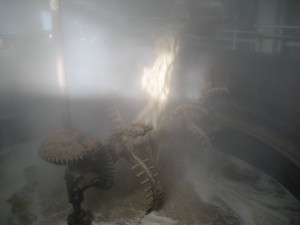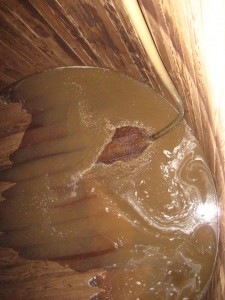I am now 24 hours into a new way of looking at whisky: from the inside. For the next two weeks, I am learning all there is to know about whisky making from the innovative experts at Bruichladdich Distillery (www.bruichladdich.com) through immersion — not in whisky, but in the process.
At the invitation of distillery manager and whisky legend Jim McEwan, I am going to essentially shadow the Bruichladdich team in all facets of production. For the past two days, I’ve been working with PG and Peter in the mash house. It’s here that the malted barley is mixed with hot water to draw out the sugars, which are eventually converted into alcohol in the fermentation and distillation processes.

Bruichladdich has a rare four-wash mash cycle (compared to the standard three) in which the last two washes go into the first two washes of the next mash. This draws even more sugar out of the grain. Each cycle takes about 6-8 hours. The wort (sugar-rich water) from the first two cycles are piped to the washbacks in the adjacent tun room, where it ferments (once yeast is added) in a 35,000 liter pine washback for 60-70 hours.
At any given time, four of the six washbacks are filled and are in various stages of fermentation. One washback could be bubbling like a witch’s gigantic cauldron, as the reaction from the yeast throws off hot carbon dioxide. Another washback could be enjoying the calm from the end of the fermentation process and, in fact, contain a fruity, fizzy “beer” that is strangely drinkable.
PG and Peter came to the whisky life years ago from other careers (fisherman and farmer), and expertly execute their jobs (including milling the barley several times a week). The mashing process is a slow one, so there is often time spent watching barley bubble in the hot water or doing other minor tasks. But when it comes time to empty or fill the mash tun, it’s a flurry of activity with multiple levels of valves needing to be opened, temperatures to be watched and maintained, and mash to be stirred.

My tasks were minor, carrying and dumping yeast into the cavernous washbacks, but I still had an important introductory education. My biggest impression is how much character of the final spirit is imparted in the mashing process. Bruichladdich claims 60 percent of the final character is developed in this stage. Based on the cereal and fruit aromas I noticed growing increasingly stronger as the wort fermented, and even as the sugars were being drawn from the barley in the mash tun, I’d have to agree.
It still amazes me that barley, water and yeast are these basic all-natural ingredients that end up becoming this amazing spirit. But, I guess the monks who invented whisky didn’t have much else to work with, so they made magic from mash.
Next up for me is the still room, where the fermented wash is distilled into the “spirit” of Scotch. In other words, I’ll spend the day in a furnace room, which is good considering how cold Islay’s been this week!

3 Responses to “Working for my whisky”
Rob Adkisson
Other than an accelerated fermentation time and no hops, you could be describing brewing beer. For me the smell of the bubbling wort (for beer) is one of the better smells in the world–grassy, grainy, fruity, coffee-y, sweet…. *drool* I assume whisk(e)y wort must smell similarly?
Rob
You’re absolutely right about the aroma of the wort. It’s primarily grainy/earthy with hints of fruit as the sugars are being extracted. I enjoyed hovering over the mash tun and letting the steam and aroma cover me: a free whisky spa treatment! The rich fruitiness, for me, really comes to the forefront during the fermentation process. On an important side note, the aromas you get are significantly dependent upon the grain used. In the case of the wort I worked on, it was lightly peated Islay barley. A heavily peated barley grown on the mainland would have some different characteristics, both in the mashing and fermentation processes.
Angellaa
Hmm, very cognitive post.
Is this theme good unough for the Digg?